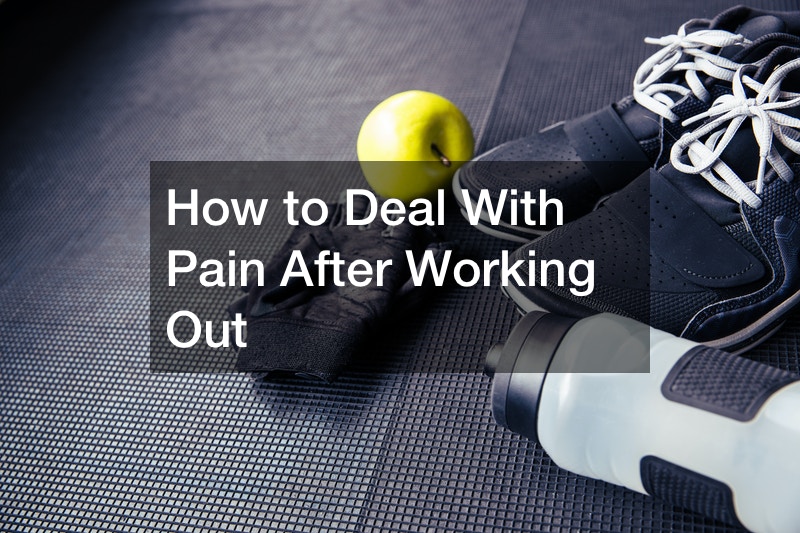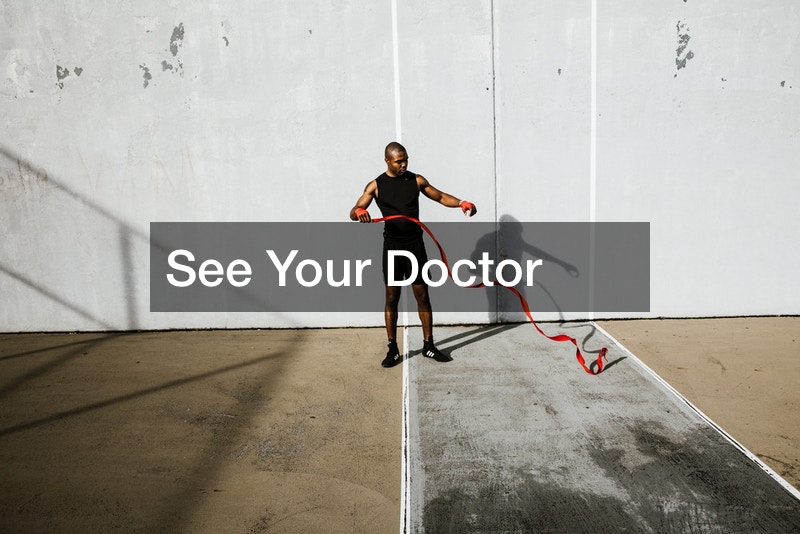
Exercise is often lauded as the solution to stress. In many cases, this is true. Physical activity lowers blood pressure, reduces the stress hormone cortisol, improves sleep, releases endorphins, and regulates your hormone levels.
However, working out can also sometimes lead to aches and pains. While feeling sore is normal, you shouldn’t be feeling extraneous swelling, inflammation, or pain. That said, if you are experiencing pain after working out, there may be some common reasons why. Here are some key ways you can reduce pain after you work out and how you can improve your fitness routine.
Make Sure You’re Using Proper Form
Whether you are swimming, running, or lifting weights, proper form is absolutely critical. Often, one of the first recommendations from sports medicine physicians is to double-check your form — and with good reason.
Improper form can lead to injury and limit the results you see even with regular exercise. Bad form may lead to short-term, acute injuries or much more serious, chronic injuries. If you perform an exercise the wrong way, over time, you strengthen the wrong muscles to support that movement. Because you do not have adequate support for that particular motion, you risk seriously injuring yourself from that repetitive movement. Further, poor technique limits your progress. Without the correct form, you will only derive some of the benefits from strength training, running, and other forms of exercise.
There are several different ways to correct your form. Attend group classes for your chosen activity, hire a fitness coach or personal trainer, or attend an event. For example, many local running stores host running form workshops periodically throughout the year.
Are you struggling to come to terms with how to deal with pain after working out? The best solutions are preventative. Stop pain in its tracks by working to improve your form.
See Your Doctor
To learn how to deal with pain after working out, talk to your doctor. Your doctor will likely suggest some science-backed ways to help alleviate and prevent exercise-related pain, including:
- RICE. RICE is an acronym that stands for rest, ice, compression, and elevation. It is among the most commonly recommended treatments for sore muscles and minor injuries. To keep pain at bay, take a few days off from your chosen activity, apply ice, wear compression socks or wrap the affected area in an Ace bandage, and/or elevate your sore limb until it feels better.
- Stretch before and after your workouts. Doctors at reputable medical clinics will ask you about warming up and cooling down after your workouts. Do not underestimate the importance of stretching. Getting your blood flowing before a workout is vitally important. If you prefer a more dynamic stretch, you can do light activity that gets your blood circulating and prepares you to complete the motions associated with your preferred activity.
- Massage the affected muscles. Head over to a medical wellness clinic for a sports massage with a certified massage therapist. If you want a more immediate solution, you can massage your sore muscles at home or use a foam roller to work out any kinks or points of tension.
- Use over-the-counter pain relievers or topical creams. Over-the-counter pain relievers or topical creams work just fine to help treat mildly sore muscles. Take as needed, and consider pairing with other steps if you are still experiencing pain.
If you are still experiencing pain after faithfully trying out these methods — or you need a little more input from your doctor — consider asking pertinent questions. Ask how to tell the difference between sore muscles and injuries, the warning signs leading up to an injury, normal recovery times for sore muscles, and check-in with your doctor to ascertain that your pain is from sore muscles, not from something more serious. Of course, if you are experiencing acute pain or other symptoms typical of a serious injury, skip the routine doctor’s appointment and head straight to an urgent care clinic.
Get Physical Therapy and Treatment
Wondering how to deal with pain after working out? One of the first steps is knowing that moderate to severe pain after working out is not normal. The next step is doing something about it. Rehab and physical therapy can help prevent injuries, treat existing ones, and eliminate the need for more serious interventions, like surgery. Here are some of the key benefits of physical therapy.
- Physical therapy treats pain. Ideally, back pain treatment can be entirely opiate-free. One way to treat back pain without a drug regimen is physical therapy. Physical therapists will work with you to stretch and move your body in ways that effectively reduce pain over time.
- PT staves off injuries. One of the most critical steps when it comes to how to deal with pain after working out is preventing injury in the first place. Whether you have suffered an injury and want to avoid hurting yourself again — or whether your doctor tells you that you are vulnerable to injury — physical therapy can help. When you meet with a physical therapist, they can evaluate the strength of your joints and various muscle groups. From there, they can pinpoint what areas need work. Once they have determined where you have room for improvement, they can work with you to properly train and strengthen those particular joints, tendons, and muscles.
- Physical therapy benefits your overall health. While it may not be necessary for all patients, physical therapy can treat a variety of common health problems, including respiratory disease, cardiovascular disease, and age-related conditions like type 2 diabetes, osteoporosis, and arthritis. If you have a heart or lung condition, a doctor will often refer you to a physical therapist. While working with a PT with these particular conditions, they will take you through motions that mimic your day-to-day activity and make sure that you are able to safely and effectively function. If you are struggling, they will help you overcome any challenges you may have. Physical therapy can also help manage blood sugar levels and treat persistent joint pain.
- Physical therapy may eliminate the need for surgery. It is entirely possible to receive foot injury treatment without any surgery — and that includes treatment for severe injuries as well.
What are the best strategies about how to deal with pain after working out? If you are experiencing chronic pain, physical therapy is one of the best tools at your disposal to treat pain, prevent injury, and strengthen your bones and muscles for more effective, pain-free workouts.
Try Knee Braces or Compression Socks
Sometimes the most effective approach when it comes to how to deal with pain after working out is to keep it simple. You may be able to reasonably and successfully treat pain at home using medical supplies that you can buy at the store or get reimbursed for by filing a claim with your insurance agency.
Specifically, those medical supplies include anything that applies compression, shifts or redistributes your weight, or reduces swelling and inflammation. Examples may include:
- Ace bandages and compression socks. Compression socks work by stimulating blood flow between your heart, legs, and feet. Healthy blood circulation reduces pain, swelling, and inflammation. Certain types of compression socks or compression stockings may require a prescription. For example, graduated compression socks are available in varying degrees of compression, often with the compression gradually tapering off near the top. Work with your doctor or another medical professional to get fitted for graduated compression socks.
- Ace bandages promote healthy blood flow. They apply even, gentle pressure to combat pain and swelling. Ace bandages are more adaptable than compression socks or compression stockings. You can apply them wherever you need relief. This may include your wrist, ankle, or knee.
- Arm, knee, and ankle braces. If you have recently been injured, that injury may affect your gait or the way you distribute your weight while walking or going about daily activities. The reason is simple. When our limbs, muscles, or joints are sore, we tend to do what we can to avoid putting an undue amount of weight on affected areas. However, this can further weaken muscles and joints and make the problem worse. Braces help support your knee, wrist, or ankle and ensure that it bears weight (if any) evenly and without pain. For minor ailments, you may be able to purchase a brace over-the-counter at a pharmacy or a medical equipment company. For more serious injuries, talk to your doctor. If you are wondering how to deal with pain after working out, a brace can be a simple and easily accessible solution.
- Kinesiology tape. Kinesiology tape is a stretchy, cotton and nylon tape that mimics your skin’s elasticity. By applying kinesiology tape to the right areas, the tape helps reduce joint inflammation, changes critical pain signals, improves blood circulation, and encourages healthy circulation of lymphatic fluids. Ultimately, kinesiology tape or KT tape reduces pain, re-trains muscles, and supports weak joints and muscles. According to Healthline, many athletes, including marathon runners, regularly use kinesiology tape during big events to improve their performance.
Regular exercise comes along with a whole host of benefits. Physical activity improves your mood and promotes good mental health, strengthens bones and muscles, keeps your weight in check, improves brain function, and encourages quality, restful sleep. It can even reduce your risk of cardiovascular disease and certain cancers, like breast cancer, lung cancer, and colon cancer, and help you live longer.
Don’t miss out on the many benefits of exercise because of pain. Keep pain at bay and learn how to deal with pain after working out by following the tips and tricks above. Treating pain may be as simple as using compression socks or Ace bandages, improving your form, talking to your doctor, or taking advantage of rehabilitation and physical therapy as necessary.




